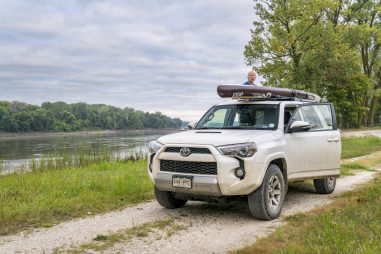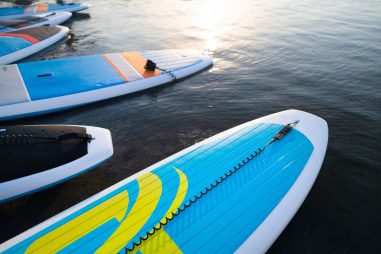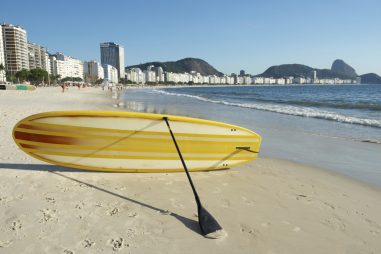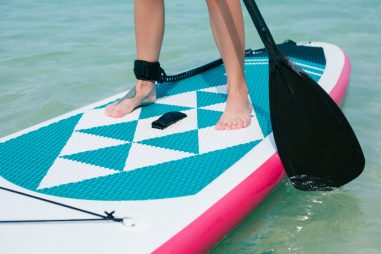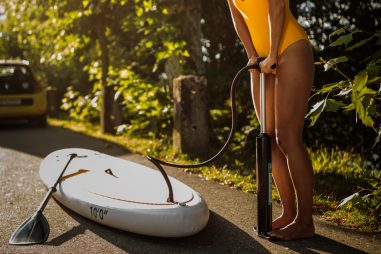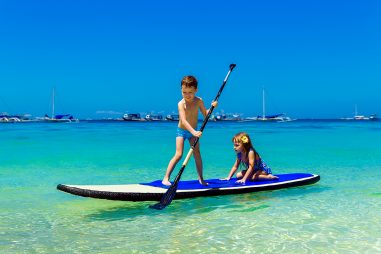Of course, one does not get to the advanced or expert level without going through some essential steps. First off, you need to get proper instructing so you start off on the right footing so to speak. Getting a good foundation in the sport makes it easier for you to progress. So, get a good instructor to help you develop correct paddle boarding habits that will stick with you for a long time as you progress in this sport.
How Do I Learn to Paddle Board?
Get yourself a good instructor and buy or rent the right paddle boarding equipment. We suggest renting a beginner paddle board at first and buy your own board and accessories later. You will very quickly outgrow the beginner’s board especially if you are the athletic type. Buying your own gear later makes sense when you already know your preferred style of paddle boarding as there are different types for different styles of paddle boarding.
Below are a few tips for you when you start to learn paddle boarding:
- First, safety. Wear a life vest. You never know when you are going to need it so putting one on gives you a margin of safety. Another marginal but significant item to have is a whistle in case you get in trouble. Clip it to your life vest within easy reach.
- Use a leash to tether the board to yourself. You don’t want to lose your board when you find yourself a little too far from the shore. A paddle leash is also a good option to have so you don’t have to chase it every time you drop it in the water.
- As its name suggests, a beginner paddle board should be used by those new to the sport. This type of board is the most stable and therefore the easiest to learn on. Make sure this is what you have when learning the sport.
- Learn to paddle board first on calm flat water. Avoid rough water at first as this will make it harder for you to learn.
- Check the wind conditions and weather in general. You want to have your first lesson hopefully in ideal conditions.
Is Paddle Boarding Easy or Hard to Learn?
Paddle boarding is one of the easiest water sports to learn when compared to surfing, kiteboarding, windsurfing, and other water sports. Unlike these extreme sports, paddle boarding does not need you to be an uber athlete to be proficient at it. You don’t have to be super fit to start paddle boarding although it certainly helps if you are reasonably fit.
Another significant factor in learning to paddle board is that you can set your own pace. You may take breaks when you need to and you can even take breaks on your board. As your skill level advances, of course, you will want to look for new challenges. You might find paddle boarding in calm water to be lacking in excitement. In that case, you can look forward to the more active parts of this sport.
How Do You Train for Paddle Boarding?
As we have said earlier in this article, you don’t have to be super fit to get into paddle boarding. Having said that, a reasonably fit body will get more benefit from paddle boarding. So how do you get your body prepared to paddle board? Below are a few basic exercises to help you get primed for paddle boarding. It might be a good idea to check with a medical professional before doing some serious workouts just to make sure you don’t have medical issues that might need to be dealt with first.
- Core muscle exercises to help generate paddling power. You can go to a gym and get some instructions on what works best for you or as more common these days, find online resources for core muscle exercises.
- Shoulder and arm muscle exercise to build endurance as you would normally use these muscles continuously.
- Cardio exercises to build up your heart and lungs. Swimming would be a natural complement since you are already in the water.
- Leg and calf muscle exercises to strengthen them and help with your balance.
Do You Need Lessons to Paddle Board?
Yes, taking lessons is highly recommended especially if you don’t have any experience in any of the water board sports such as surfing or windsurfing and the like. The benefits of taking lessons are many. Some of them are listed below.
- You gain confidence since you know you have prepared yourself as well as you could to tackle the sport.
- You learn the basics and you get a good foundation to build on.
- You won’t spend so much of your time trying to climb back on your board.
- You will learn how to keep yourself safe and how to deal with emergencies should something unexpected happens.
- You develop social skills when taking lessons with a group.
How Can I Practice Paddle Boarding at Home?
Unless you have a pool at your home it will be tricky to practice paddle boarding at home. But, yes, you can practice some of the paddle boarding moves at home if you don’t mind looking a little silly in front of your family. Some of the moves you might do are:
- You can practice your balance with a balance trainer at home. This will help you in maintaining your balance which is crucial in paddle boarding. It will also exercise your core so you get that benefit too.
- You also get to practice your stance on the balance trainer.
- If you have your own board, try carrying it and see what feels most comfortable for you. Some people have a difficult time carrying their board so a few minutes of finding what works for you will save you a lot of pain in the long run.
- Unfortunately, there are no paddling trainers or ways to effectively practice how to paddle at home. The operative word here is effectively. You may practice the stroke similar to what tennis players do in “shadow tennis” but it’s not going to be the same as actual paddling.
How Can I Improve My Paddle Boarding?
In any sport, there is always room for improvement no matter how small. Paddle boarding is no exception, there are always ways you can improve your performance. Some of them might be in your equipment or some of them might in your technique. Whatever the case, you can always heighten your enjoyment of the sport if you make the effort to improve and expand your range. Below are several areas where you may be able to improve your paddle boarding experience.
- Adjust your stance: Good paddle boarders are always adjusting their stance or feet position depending on the situation and maneuver they are performing. At the start, you should be standing on the center of the board since this gives you maximum stability. Your feet must be parallel to each other or even angled slightly away from each other, whatever feels more comfortable for you. Stand with your feet more or less at shoulder width and keep your weight distributed evenly between them. Bend your knees slightly, this will help you keep your balance.
- Next is posture: Improving your posture will not only elevate your paddle boarding performance but lessen the strain on your back, arm, and leg muscles, a big payoff for small adjustments. We have already discussed the correct position of your feet and how your knees should be slightly bent. Other things to remember are keeping your shoulders back, your back straight, your head up looking at the horizon and your hips facing squarely forward.
- Your paddling technique:
- First, adjust your paddle length to fit your height and arm length. The hands up method of measuring the correct paddle length is to stand with the paddle next to you and reach as high as you can. The grip of the paddle should be adjusted to the bend of your wrist.
- The next step is to grip your paddle like a pro. One hand should be on the T-bar and the other on the shaft. The recommended distance between your two hands is located by placing the paddle on the top of your head with one hand on the T-bar and one on the shaft. Slide your hands along the shaft until both of your arms form a right angle on either side of your head. This is the ideal position of your hands when paddling.
- Remember to keep the blade facing away from you when paddling. Your paddle is designed this way so as to get maximum results when used.
- Routinely switch the side on which you are paddling on. This allows you to exercise your whole body, not just one side.
- The paddling stroke is broken down into four motions. However, the four actions should flow into one continuous smooth stroke to be efficient. With the reach and dip, you reach as far as you could forward and submerge the whole blade in the water. Your back should remain straight, your arms fully extended, your knees slightly bent and your feet shoulder-width apart. The power stroke is all about power. By engaging your core muscles as you pull your paddle through the water, the power is transferred from your core through your arms and onto the paddle. The exit and release phase should come naturally as you pull your paddle out of the water. The paddle should come out of the water at your feet’s position. Pulling the paddle out of the water behind your feet will cause you to decelerate. The recovery and transition phase begins as soon as you pull your paddle from the water. Release the tension from your muscles and take a deep breath before positioning your paddle for the next reach and dip. Maintain your posture as you transition to the next stroke.
- Lastly, your paddle boarding equipment: They play a part in your improvement. You must use the right type of board for your style of paddle boarding. If you’re into long-distance, fast-paced paddling, then you will be better off with a touring paddle board. They are ideal for ocean paddling and even for SUP racing. On the other hand, an all-around paddle board is versatile enough to be used in a variety of paddling activities like SUP fishing, SUP yoga, SUP surfing, exploring, and similar activities.
How Do You Get Good at Paddle Boarding?
Practice, practice, practice. Nothing beats practice so you can get really good at anything including paddle boarding. But you have to practice with the correct technique or the bad habits will get ingrained.
An overlooked way to get really good at paddle boarding is to ask questions and learn new moves. We can always learn something new from unexpected sources. So, don’t be embarrassed to ask “stupid” questions. Athletes always copy each other’s brilliant moves. That is how they add to their growing repertoire. There is no reason why you should not do the same.
How Do You Paddle Board Like A Pro?
Once you get hooked on this sport, of course, you will want to be able to paddle board like a pro. Below are a few tips to get you on your way. Some things may not be noticeable except to the expert paddle boarders but those small things make a huge difference in your performance.
- Get in shape. You might not have the physique of a pro paddle boarder but getting reasonably fit will go a long way in keeping you free of injuries. Although the sport might be practiced by people of all shapes and sizes, being fit helps. Core, leg, calf, shoulder, and arm exercises are the foremost exercises you will need.
- We have talked about this before but it bears repeating. Get the correct paddle for yourself. A lot of your paddling effort will be wasted if you are not using the correct paddle for your height.
- Practice your stroke. If you can find somebody to critique your stroke, that person can point out some adjustments you might need to make. Or you may videotape yourself while paddling or just practicing your stroke and you might be able to spot some flaws in your technique that you might want to work on.
- Work on maintaining your posture and balance. You will run into different weather and water conditions while paddle boarding. Maintaining your balance will always be key to your performance.
Is Paddle Boarding Difficult to Learn?
Learning to paddle board will be difficult only if you’re not doing it in the right conditions. Let’s consider the three things to avoid when you’re just starting out. First, use a paddle board with enough volume so it has sufficient stability and so you don’t get thrown off the board when the first small wave comes along. Second, stay away from rough water your first time out. You will want to have your first session in calm water. It will be a challenge just maintaining your balance if you are in choppy water on your first paddle board ride.
Third, the wind is not your friend at this stage. It can push you in directions that could actually get dangerous. With the wind at your back, you will find it to be easy sailing. But when you have to turn back you will be going against the wind and this is when it gets hairy. Avoid windy conditions at this time.
How Difficult Is Paddle Boarding Actually?
As has been repeatedly said, learning to paddle board is not difficult at all. You can be paddling on your own after your first lesson. Mastering it and getting good at it, however, is a different thing. It takes time to be a good paddle boarder. You need to get out on the water as much as possible to progress.
As you master the basics and move on to the advanced level, you can take out your paddle board to lakes, rivers, or the sea. You can try out the different paddle boarding environments like SUP surfing, long distance paddle boarding, SUP fishing if you’re into fishing as well, or SUP yoga if that’s your cup of tea. Whatever your interest is, paddle boarding will have something for you even if it’s just a lazy day hanging out at the water for you.


